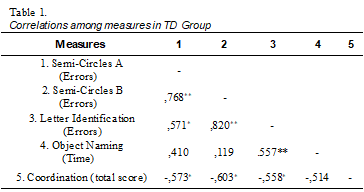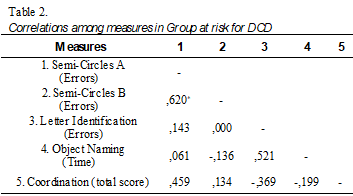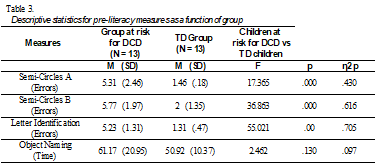INTRODUCTION
The practice of physical activity is very important element of promoting health and motor and cognitive development during childhood (Gil, Contreras and Gómez, 2008; Herrero, 2000; Molina, Garrido and Martínez-Martínez, 2017; Reloba-Martínez et al., 2017). Note that the majority of studies are usually focused on primary school or secondary education, being more rare in children aged 3 to 6 years (Calahorro et al., 2014).
Developmental Coordination Disorder (DCD) is a neurodevelopmental disorder, ranging between 5 and 6% in the school-age population, previously characterized by motor deficiencies which significantly and persistently interfere with everyday life activities appropriate to the individual's chronological age (prevocational/vocational, leisure and play activities) and school achievement. This is characterized by an acquisition and execution of coordination skills below that we expect for chronological age despite appropriate opportunities for learning and the absence of intellectual disability, visual or neurological impairment (APA, 2013). Children with DCD, compared to typically developing (TD) children, are generally described as usually showing clumsiness in their behaviors, slowness and inaccuracy in their motor performances on tasks, such as catching an object, using scissors and cutlery, handwriting, riding a bike, or participating in sport activities (Missiuna et al, 2014; Summers, Larkin and Dewey, 2008; Vaivre-Douret, Lalanne and Golse, 2016 Vaivre-Douret, Lalanne and Golse, 2016; Wang et al., 2009; Zwicker et al., 2011).
An important area of impairment is the school achievement; children with DCD are likely to have specific problems with learning at school such as dyslexia, dyscalculia and dysgraphia (Biotteau et al., 2017; Nicolson and Fawcett, 2011; Prunty et al., 2016). However, there is almost no information about literacy readiness in young children aged 3-6 years despite the increasing research interest in the relationship between motor and cognitive abilities (Carson et al., 2016; Coleman, Piek and Livesey, 2001; Franco and Justo, 2009; Herrero, 2000; Michel, Molitor and Schneider, 2018; Piek et al., 2004; Torres-Luque et al., 2016). Literacy readiness refers to a set of pre-literacy skills acting as predictors of later literacy outcomes. This includes oral language skills, such as vocabulary, comprehension and listening, alphabetic abilities such as phonological/phonemic awareness and knowledge/understanding about print and its use (Pinto et al., 2016; Puranik and Lonigan, 2011; Shanahan and Lonigan, 2010).
Given these concerns, this study aims to compare the literacy readiness of kindergarten children at risk for DCD and TD peers. Thus two following specific hypotheses were tested: 1. Coordinative skills would correlate with pre-literacy skills; 2: Children at risk for DCD would show worse performance on tasks measuring literacy readiness compared to TD peers.
The term "children at risk for DCD" is used as follows clinical recommendations that the diagnosis of DCD should be usually made not before 5 years, although the onset may be identified at earlier ages (Blank et al., 2012). To do this, a screening was done on all kindergarten children from one public school located in quarter of medium socioeconomic level (Alesi, Pecoraro and Pepi, 2018).
METHODS
Participants
Participants were 100 Italian children attending kindergarten schools. Of these, 13 were identified at risk for DCD (8 boys and 5 girls) who had a mean chronological age of 5.1 years old (± .9; age range: 4-6) using DSM-5 criteria (APA, 2013): 1. scoring at or below the 15th percentile on a standardized coordination test, the Movement Assessment Battery for Children-2 (Henderson, Sugden, and Barnett, 2007); 2. Parental self-report measures of motor impairment interference with daily and school living (prevocational/ vocational, leisure and play activities); 3. absence of a diagnosis of intellectual disability, visual or neurological impairment; 4. absence of a diagnosis of other neurodevelopmental disorders.
Remaining 87 children with TD scored at or above the 16th percentile on the MABC-2 indicating typical coordination skills. Additional inclusion criteria were: 1. absence of a diagnosis of intellectual disability, visual or neurological impairment; 2. absence of a diagnosis of neurodevelopmental disorders. Of these 13 children, matched for gender, were randomly chosen and assigned to a comparison group.
Children at risk for DCD and TD children were recruited from kindergarten schools (Alesi, Pecoraro and Pepi, 2018). The catchment areas of these schools were predominately of middle socioeconomic status as judged by parents' education and employment. The parents gave informed written consent.
Measures and Procedure
Motor Coordination Measure
Motor Coordination was assessed by the MABC-2 (Henderson et al., 2007), a standardized test to assess motor proficiency in children ranging 3 to 16.11 years. It is composed of eight subtests clustered in three areas: 1. manual dexterity; 2. aiming and catching; 3. static and dynamic balance. A total score and scores for each area as well as percentile scores were obtained.
Pre-Literacy Skills Measure
Pre-Literacy skills were measured through the PRCR -2/2009 (Cornoldi et al., 2009). This is a battery of standardized tasks aimed at measuring general and specific prerequisites to later reading and writing abilities in kindergarten children. Three tasks were derided by the PRCR-2/2009 battery and used in the present study: 1) Semi-circles (Version A and B); 2) Printed letters identification; 3) Objects naming.
The Semi-circles tasks measured the visual memory of differently oriented printed signs. They were composed of a list of 10 single signs (Semi-circle A) and a list of a pair of signs (Semi-circle B). A child was showed one item at a time and, when the sign was hidden, the child was required to reproduce it on a blank sheet. The score was the number of errors.
The Printed letters identification task measured the visual analysis ability, the visual discrimination and the spatial orientation. It was composed of a sheet with 12 target letters printed on the left and 4 letters for each target (the target and 3 distractor letters) printed on the right. A child was required to recognize and cross the target letter. The number of errors for the task was recorded. The final score was obtained by adding together the number of errors.
The objects naming task measured the linguistic proficiency, the visual attention and the sequentiality of eye movements. It was composed of 30 objects in 5 sequences of 6 objects for each. The objects were for example animals (a mouse, a cat, a chick), flowers, an ice-cream, a sun, a star…
A child was required to rapidly name the sequence of the objects from left to right and from the top to bottom. The execution time for the task were recorded. The final score was the time.
At the beginning of the research, a screening was done on all kindergarten children (N=100) from one public school located in quarter of medium socioeconomic level.
The screening was carried out over 2 months. Children were tested on the MABC-2 (Henderson et al., 2007), a standardized test composed of three coordinative areas (manual dexterity, aiming and catching, static and dynamic balance) which is commonly used in the diagnosis of DCD. After the screening, 13 children met criteria to be considered at risk for DCD scoring at or below the 15th percentile. These children were compared with 13 TD children randomly derived from the group of 87 children with typical coordinative proficiency on literacy readiness tasks.
The ethical requirements relating to data collection were scrupulously respected and approval was obtained from the Ethics Committee of the University of Palermo (L'Università degli Studi di Palermo, Italy).
RESULTS
Correlation analyses were performed to assess the association between motor coordination and pre-literacy skills in both groups. Results showed that, in TD Group, the coordination proficiency was negatively associated with the number of errors in the Semi-circles A (r= -.573; p=.041) and Semi-circle B (r= -.603; p=.029) and the number of errors on the Letter Identification task (r= -.558; p=.048) (Table 1). Whilst, in the Group at risk for DCD, no significant associations were found among coordination proficiency and pre-literacy skills (Table 2).
Moreover, one Multivariate analysis of variance (MANOVA) was performed to compare pre-literacy outcomes in the two groups. The independent variable was the group (children at risk for DCD and TD), whilst the dependent variables were the scores on Semi-circles A and Semi-circle B, Letter Identification and Object Naming tasks. Most differences were significant except for the time of Object Naming. There was a significant effect of the group on the performance on the Semi-circles A task [F(1, 25)= 17.365; p=.000; η² =.430] and Semi-circles B task [F(1, 25)= 36.863; p=.000; η² =.616]. Moreover, on the errors in the Letter Identification, there was also a significant difference [F(1, 25)= 55.021; p=.000; η² = .705].
Thus, children at risk for DCD showed worse performance on all these pre-literacy assessments compared to TD children. Descriptive data are showed in Table 3.
DISCUSSION
This study provided a comparison of pre-literacy skills among a group of Kindergarten children at risk for DCD and a group of chronological age matched TD children. Firstly, in TD Group, the coordination proficiency was found to correlate negatively with the errors on Semi-circles A and Semi-circle B tasks and Letter Identification task. The typical acquisition and execution of coordination skills, as expected for chronological age, are associated with pre-literacy skills such as visual memory of differently oriented printed signs, visual analysis ability, the visual discrimination and the spatial orientation. However, these associations were not revealed in Group at risk for DCD. All together these findings corroborate the hypothesis that children with DCD have specific visuospatial difficulties which are demonstrated by their poor performance on nonverbal EF tasks, including fluency, working memory and inhibition (Leonard et al., 2015). Moreover, significant differences between the Groups were found for most of the tasks which measured the specific prerequisites to later reading and writing abilities before the primary school. Children at risk for DCD were significantly worse than the TD peers on the most measures (Semi-circles A and B, Letter identification, Object naming) that assessed the visual memory of printed signs with different orientation, the visual analysis ability, the visual discrimination and the spatial orientation linguistic proficiency, the visual attention and the sequentiality of eye movements. This would be due to an impaired Executive Functioning (EF) profile in DCD resulting in a worse performance working memory, dual-task and metacognition tasks (Houwen et al., 2018; Vaivre-Douret et al., 2011; Wilson et al., 2013). Previous research also has demonstrated poorer performance on visuospatial executive-loaded working memory and fluency in school children with DCD (Leonard et al., 2015). Furthermore, Kindergarten children at risk for DCD demonstrated impairment on EF as visuospatial working memory, verbal fluency and inhibitory control abilities (Alesi, Pecoraro and Pepi, 2018). On the whole, these are higher order cognitive processes representing important prerequisites for school readiness. More in detail, abilities as to manipulate mental items stored in working memory, control and repress a prepotent response, switch the attention from one task to another, plan learning actions, all together, contribute to empower children to be able for later literacy and numeracy achievements in primary school.
No significant differences were found on the time of Object Naming. It is possible that the ability to recognize and name rapidly a printed stimulus requires the automatization of perceptual processes and needs more time to be better managed.
CONCLUSIONS
To sum up, the findings of this study show that, since kindergarten, the children at risk for DCD not only have impairments to their motor system, but they also have deficits in pre-literacy domain. Although DCD is often seen only as involving the motor system and resulting in clumsiness, slowness and inaccuracy in motor performances, the effects of DCD extend to other cognitive systems such as pre-school and later school abilities. Notwithstanding the shortcoming of a limited sample size, the evidence from this study about the links between motor impairments and literacy readiness, whilst preliminary, suggests some interesting implications on the educational field for future practice. It is advisable to plan cognitively challenging motor and physical activities programs aimed at improving coordinative and cognitive development since kindergarten school.

















